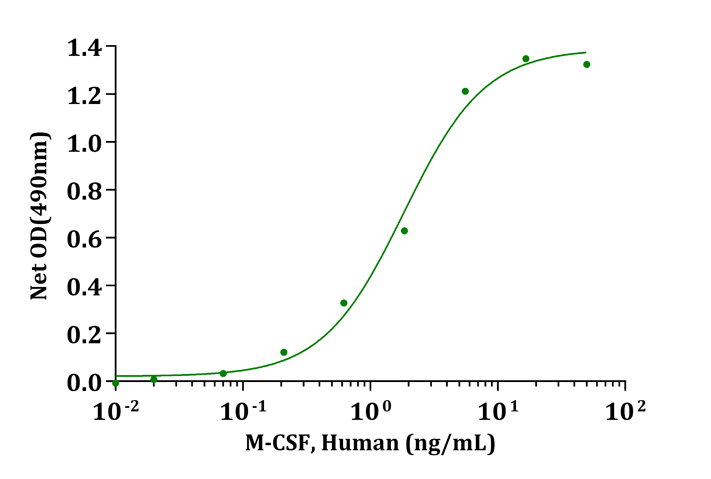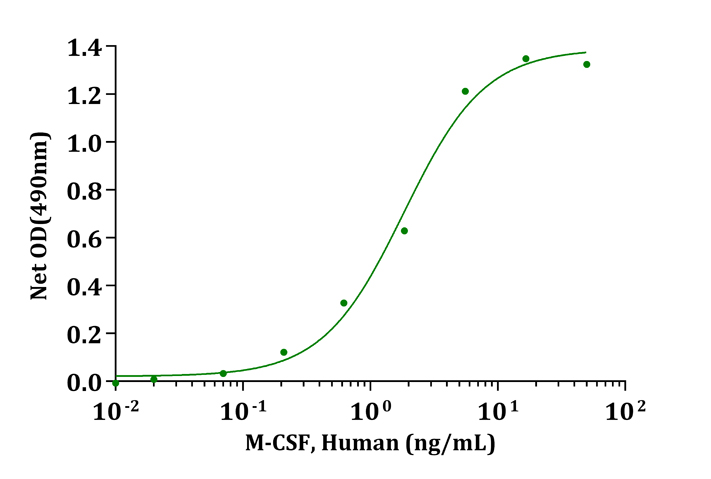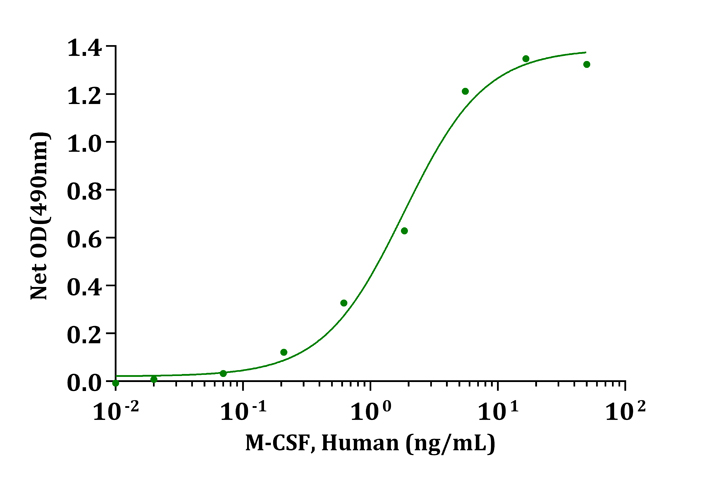| Species |
Human |
| Protein Construction |
Expressed with an N-terminal Met.
M-CSF (Glu33-Ser190)
Accession # P09603-3 |
|
| Purity |
> 95% as analyzed by SDS-PAGE |
| Endotoxin Level |
< 1 EU/μg of protein by gel clotting method |
| Biological Activity |
ED50 of 1.0-3.0 ng/ml, measured by cell proliferation assay of M-NFS-60, corresponding to a specific activity of 3.3 × 105-1.0 × 106 units/mg. |
| Expression System |
E. coli |
| Apparent Molecular Weight |
~28 kDa, on SDS-PAGE under non-reducing conditions. |
| Formulation |
Lyophilized after extensive dialysis against 50 mM Tris-HCl, pH 8.0. |
| Reconstitution |
It is recommended that this vial be briefly centrifuged prior to opening to bring the contents to the bottom. Reconstitute the lyophilized powder in ddH₂O or PBS or Tris-HCl, pH 8.0 up to 100 μg/ml. |
| Storage & Stability |
Upon receiving, this product remains stable for up to 6 months at lower than -70°C. Upon reconstitution, the product should be stable for up to 1 week at 4°C or up to 3 months at -20°C. For long term storage it is recommended that a carrier protein (example 0.1% BSA) be added. Avoid repeated freeze-thaw cycles. |


Biological Activity
M-CSF, Human (Cat. No. Z02914) stimulates cell proliferation of M-NFS-60 cells. The ED50 for this effect is typically 1-3ng/mL.

2 μg of M-CSF, Human (Cat. No. Z02914) was resolved with SDS-PAGE under reducing (R) and non-reducing (N) conditions and visualized by Coomassie Blue staining.

Biological Activity
M-CSF, Human (Cat. No. Z02914) stimulates cell proliferation of M-NFS-60 cells. The ED50 for this effect is typically 1-3ng/mL.

2 μg of M-CSF, Human (Cat. No. Z02914) was resolved with SDS-PAGE under reducing (R) and non-reducing (N) conditions and visualized by Coomassie Blue staining.

Biological Activity
M-CSF, Human (Cat. No. Z02914) stimulates cell proliferation of M-NFS-60 cells. The ED50 for this effect is typically 1-3ng/mL.
| Target Background |
Macrophage-Colony Stimulating Factor (M-CSF), also known as Colony Stimulating Factor-1 (CSF-1), is a hematopoietic growth factor. It can stimulate the survival, proliferation and differentiation of mononuclear phagocytes, in addition to the spreading and motility of macrophages. In mammals, it exits three isoforms, which invariably share an N-terminal 32-aa signal peptide, a 149-residue growth factor domain, a 21-residue transmembrane region and a 37-aa cytoplasmictail. M-CSF is mainly produced by monocytes, macrophages, fibroblasts, and endothelial cells. M-CSF interaction with its receptor, c-fms, has been implicated in the growth, invasion, and metastasis of of several diseases, including breast and endometrial cancers. The biological activity of human M-CSF is maintained within the 149-aa growth factor domain, and it is only active in the disulfide-linked dimeric form, which is bonded at Cys63. |
| Synonyms |
CSF1; CSF-1; MCSF; colony stimulating factor 1; Macrophage Colony Stimulating Factor; Lanimostim; MGC31930; MGI-IM |
For laboratory research use only. Direct human use, including taking orally and injection and clinical use are forbidden.










































